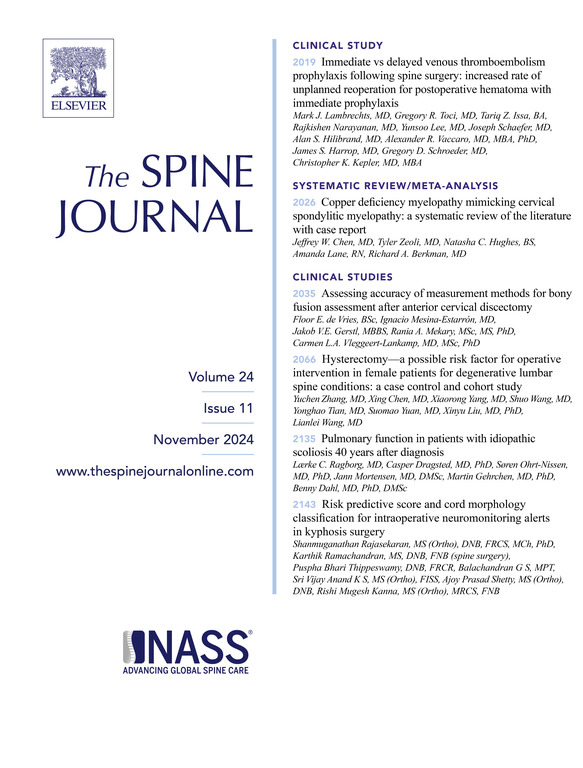Global trends and cross-country inequalities in spinal cord injury attributable to falls: a systematic analysis of the Global Burden of Disease Study 2021
IF 4.7
1区 医学
Q1 CLINICAL NEUROLOGY
引用次数: 0
Abstract
BACKGROUND CONTEXT
Falls are the leading cause of spinal cord injury (SCI), imposing profound disability, mortality, and socioeconomic burden. However, the global trends, regional patterns, and health disparities in SCI attributable to falls remain inadequately explored.
PURPOSE
To provide a comprehensive analysis of the global, regional, and national burden of SCI attributable to falls from 1990 to 2021 using the Global Burden of Disease (GBD) 2021 database. This study identifies epidemiologic trends, quantifies cross-country inequalities, and forecasts future challenges.
STUDY DESIGN/SETTING
A cross-sectional study utilizing data from the GBD 2021.
PATIENT SAMPLE
Patients from 204 countries and territories who sustained SCI due to falls.
OUTCOME MEASURES
Age-standardized incidence rate (ASIR), age-standardized prevalence rate (ASPR), and age-standardized years lived with disability (YLDs).
METHODS
Data were extracted from the GBD 2021. Descriptive analyses were conducted to evaluate ASIR, ASPR, and ASYR globally and across socio-demographic index (SDI) quintiles. Temporal trends were evaluated using joinpoint regression and age-period-cohort models. Decomposition analysis quantified the impact of aging, population growth, and epidemiologic shifts on the burden. Frontier analysis and inequality assessments assessed disparities, while Bayesian modeling forecasted the burden through 2035.
RESULTS
Between 1990 and 2021, global age-standardized rates of SCI attributable to falls declined in high-SDI regions but increased in middle- and low-SDI regions. Australasia and Western Europe had the highest burden in 2021, while East Asia and Oceania exhibited the fastest-growing trends. Population growth was the primary driver of the global burden increase, as revealed by decomposition analysis. Inequality assessments uncovered widening SDI-related disparities, with both absolute and relative inequalities. Projections through 2035 indicate a continued rise in the burden in the coming decades.
CONCLUSIONS
SCI attributable to falls poses a significant and growing global health challenge, with stark regional and socioeconomic disparities. While high-SDI regions have seen progress, rising burdens in low- and middle-SDI areas demand urgent, region-specific preventive measures and equitable healthcare interventions. Policymakers must act decisively to address demographic transitions, reduce disparities, and prioritize fall prevention strategies to mitigate the growing burden.
跌倒所致脊髓损伤的全球趋势和跨国不平等:对《2021年全球疾病负担研究》的系统分析。
背景:跌倒是脊髓损伤(SCI)的主要原因,造成严重的残疾、死亡和社会经济负担。然而,全球趋势、区域模式和因跌倒导致的脊髓损伤的健康差异仍未得到充分探讨。目的:利用全球疾病负担(GBD) 2021数据库,对1990年至2021年全球、地区和国家因跌倒造成的脊髓损伤负担进行全面分析。这项研究确定了流行趋势,量化了跨国不平等,并预测了未来的挑战。研究设计/设置:采用GBD 2021数据的横断面研究。患者样本:来自204个国家和地区因跌倒导致脊髓损伤的患者。结果测量:年龄标准化发病率(ASIR)、年龄标准化患病率(ASPR)和年龄标准化残疾生活年数(YLDs)。方法:数据从GBD 2021中提取。描述性分析在全球和跨社会人口指数(SDI)五分位数评估ASIR、ASPR和ASYR。使用连接点回归和年龄-时期-队列模型评估时间趋势。分解分析量化了老龄化、人口增长和流行病学变化对负担的影响。前沿分析和不平等评估评估了差距,而贝叶斯模型预测了到2035年的负担。结果:1990年至2021年间,全球高sdi地区因跌倒导致的脊髓损伤年龄标准化率下降,而中、低sdi地区则有所上升。2021年,大洋洲和西欧的负担最高,而东亚和大洋洲则呈现出增长最快的趋势。分解分析表明,人口增长是全球负担增加的主要驱动因素。不平等评估发现,与sdi相关的差距不断扩大,包括绝对不平等和相对不平等。到2035年的预测表明,未来几十年的负担将继续增加。结论:由于跌倒导致的脊髓损伤是一项重大且日益增长的全球健康挑战,存在明显的地区和社会经济差异。虽然高sdi地区取得了进展,但低sdi和中等sdi地区的负担不断增加,需要采取针对该地区的紧急预防措施和公平的医疗保健干预措施。决策者必须果断采取行动,应对人口结构转变,缩小差距,并优先考虑预防跌倒战略,以减轻日益增加的负担。
本文章由计算机程序翻译,如有差异,请以英文原文为准。
求助全文
约1分钟内获得全文
求助全文
来源期刊

Spine Journal
医学-临床神经学
CiteScore
8.20
自引率
6.70%
发文量
680
审稿时长
13.1 weeks
期刊介绍:
The Spine Journal, the official journal of the North American Spine Society, is an international and multidisciplinary journal that publishes original, peer-reviewed articles on research and treatment related to the spine and spine care, including basic science and clinical investigations. It is a condition of publication that manuscripts submitted to The Spine Journal have not been published, and will not be simultaneously submitted or published elsewhere. The Spine Journal also publishes major reviews of specific topics by acknowledged authorities, technical notes, teaching editorials, and other special features, Letters to the Editor-in-Chief are encouraged.
 求助内容:
求助内容: 应助结果提醒方式:
应助结果提醒方式:


